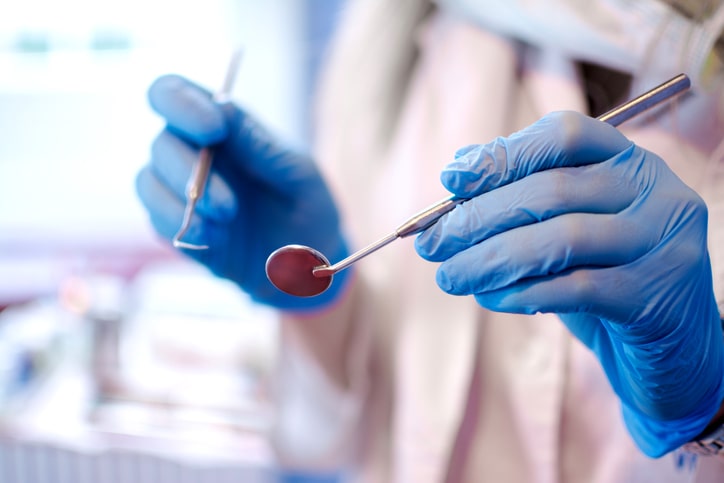If you happen to work as a dentist, a pair of gloves is essential to ensure adequate safety and protection for your hands.
Of course, Nitrile dental gloves are considered the ultimate solution by most dental professionals.
They provide better puncture protection, enhanced protection, and lesser friction while donning and doffing.
With health professionals facing the risk of germ exposure daily, using high-quality dental nitrile gloves is crucial to protect both staff and patients.
Through this guide, we will uncover everything you need to know about nitrile dental gloves.
What are Dental Gloves?
Dentists can perform numerous dental procedures effectively daily, thanks to personal protection equipment such as disposable dental gloves.
These gloves are uniquely designed wearable equipment that safeguards dental healthcare practitioners from coming in contact with or exposing themselves to harmful microorganisms.
By using these dental gloves, it further prevents the spread of infection from healthcare personnel to patients.
To perform professional dental cleanings and operations, disposable dental gloves are available in two forms:
- Hand-specific styles.
- Ambidextrous styles.
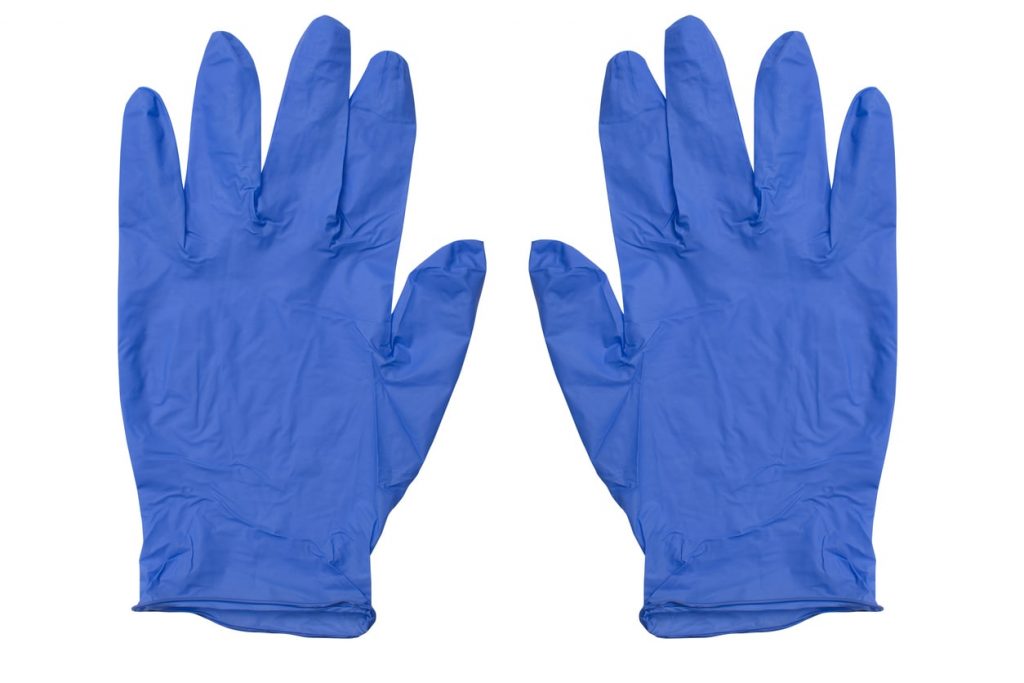
Hand-specific gloves: This style enables the thumb to remain in its natural position, preventing unnecessary strain while performing delicate dental works. They’re available in a wide range of sizes and are often found as left and right gloves.
Ambidextrous gloves: In this style, the gloves are carefully designed where the thumb is placed in line with the rest of the fingers. This type is created for both hands.
In order to promote safety and cleanliness in dental clinics, the use of dentist gloves acts as a standard protocol of defense. This is why it is critical to choose the highest-grade dental gloves in the market.
Why Dental Gloves Are Needed?
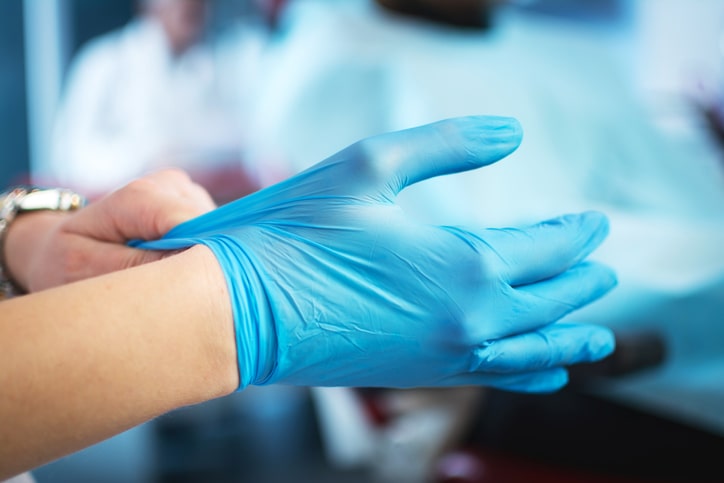
Dental gloves are a must in any dental facility to avoid all sorts of contamination.
It reduces the risk of transmission of harmful bacteria from one patient to another.
These disposable gloves play a vital role while disinfecting and cleaning dental instruments, surfaces, and other equipment.
Due to the fine and detailed work involved in dental practices, choosing glove types that ensure supreme dexterity is essential.
Dental gloves act as a vital factor for dental practice. Here’s why?
These disposable nitrile gloves protect the dentist and their patients from cross-contamination, harmful germs, and infection that might be present in the blood, body fluids, and saliva.
We often tend to forget the importance of using gloves and belittle the need to pay attention to get the right fit, quality, and material.
The federal government has formulated regulations for performing safe procedures and preventing disease transmission.
The US Center for Disease Control and Prevention has also developed guidelines for infection control in dental practices.
It’s essential to adhere to these guidelines, follow proper hygiene practices and use the right glove type to ensure adequate safety to both patients and dental clinicians.
Lastly, to enjoy a healthy and safe dental experience, dental practitioners must always don these protective gloves while attending to their patients. Protect your hands and save others with confidence!
Types Of Dental Gloves
Disposable dental gloves are essential to protect the health of dental personnel and their patients. These gloves are available in different colors, materials, and sizes. With longer shelf life, you get to buy these high-quality protective gears in bulk. Some of the popular types of dental gloves are:
-
Nitrile Dental Gloves
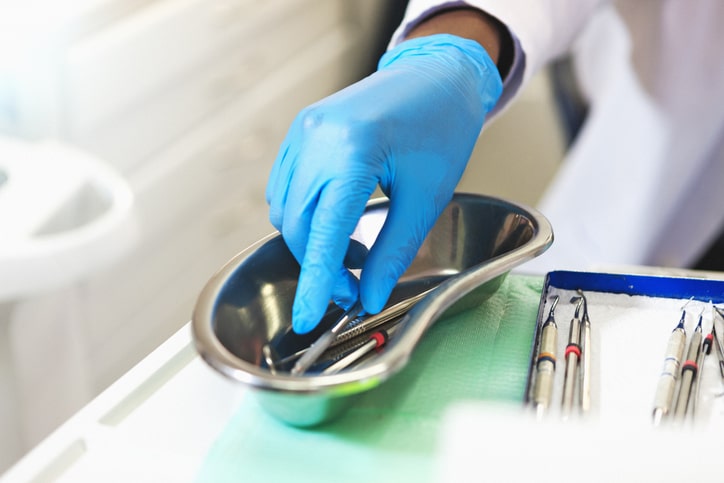
Nitrile gloves are the latest PPE option in the market for dentists. Also known as acrylonitrile butadiene rubber, Buna-N, NBR, or Perbunan, these gloves are suitable for a wide range of applications.
These superlative all-purpose dental gloves provide better puncture protection and a high level of security.
With nitrile being able to withstand most of the chemicals and solvents used for dental works, it is becoming a favorite choice among dentists.
By quickly replacing the previous industry standard option – latex gloves, these high-end nitrile gloves are much easier to don and doff due to lesser friction.
What makes nitrile dental gloves unique is that any hole or puncture is easily visible, thereby protecting the dentist and the patients from cross-contamination. Made from synthetic rubber compounds, these gloves are suitable for a wide variety of purposes.
Also, the FDA (Food and Drug Administration) conducts numerous tests on these disposable gloves to label them as medical grade, making them fit to use in the healthcare sector.
-
Vinyl Dental Gloves
Vinyl gloves are anti-static and latex-free options, suitable for clinical use and dental examinations. Due to the lower barrier, protection properties are best suited for situations that encounter lesser risks and exposure to harmful substances, bodily fluids, and blood.
Additionally, it offers a snug fit to ensure better sensitivity and delivers a great level of resistance. Often considered as the inexpensive choice, vinyl gloves are readily available and have a longer shelf life.
Using vinyl gloves, you need not worry about allergic reactions as they do not contain latex.
However, it’s best to avoid vinyl gloves that contain high levels of poisonous plasticizers like DEHP (diethyl hexyl phthalate), as it can result in anaphylaxis.
It is also not advisable to use these gloves with chemotherapeutic drugs or glutaraldehyde, alcohol.
-
TPE Dental Gloves:
TPE (thermoplastic elastomer) gloves are not suitable for performing most medical or dental procedures.
However, the waterproof protection and lightweight features make them appropriate for general use in dental clinics.
Can Dentists Use Disposable Latex Gloves?

Historically known as an industry standard for disposable gloves, most dental professionals preferred to use latex gloves.
This is due to the tactile feel and great fit while using small tools like tooth polish, scalpels, and tooth caps.
Latex gloves are known for their high sensitivity and dexterity and were among the most popular ones in the medical field until recent years.
However, repeated exposure to the latex proteins resulted in the occurrence of allergic reactions. With various individuals suffering from allergic reactions to latex components, it is advisable to check beforehand if you or your patient ate anything that they are allergic to or not.
This allergic reaction happens when the synthetic latex protein is triggered as a harmful substance by the body.
When your body tries to fight this foreign substance off, the user will experience various symptoms like slight skin irritation, redness, and even life-threatening shock.
Also, latex is not resistant to most chemicals and not puncture resistant like nitrile gloves.
Until 2017, powdered latex gloves were allowed in medical facilities as per the ADA.
As the powder mixes with the natural rubber latex protein to trigger the allergic response, the US FDA banned using powdered latex gloves in the healthcare sector, including dentistry.
Having Latex Allergy: What Alternatives Can You Opt For?
Allergic reaction to latex is a medical condition caused by the immune system’s response to synthetic latex proteins.
These lattice proteins are mainly used to manufacture medical supplies, disposable latex gloves, and other medical products.
Though hypersensitivity to these latex proteins is not fatal in most cases, it may lead to contact dermatitis. The symptoms of latex allergic reactions include:
- Swelling.
- Burning sensations.
- Itchiness.
- Skin rashes.
In case of such allergic reactions, it’s advisable to use either nitrile or vinyl dental gloves that are latex-free.
What Type Of Gloves Are Used By Dentists?
In the past, latex gloves were used mainly by dentists to perform dental operations. All credits to these gloves being extra sensitive, biodegradable, and highly elastic with a better fit.
However, the increase in latex allergic reactions rapidly became a cause of concern for dental patients.
Even dental practitioners who use these gloves might be allergic to latex. And, working with these latex gloves in the clinic can be even more difficult to battle with. These gloves degrade quickly and are vulnerable to chemical solutions.
Then again, latex gloves are economical and priced at a reasonable rate. Though they serve as excellent options in specific sectors, dentists must opt for better alternatives due to latex allergy concerns.
In dentistry, dental nitrile gloves are the best alternative to latex gloves. With the increase in popularity, nitrile utility gloves are commonly used in dental clinics while performing patient treatments, cleaning tools, or handling dental equipment.
These dentist gloves guarantee supreme hand protection than the thinner options. Also, they are heavy-duty and resistant to punctures and tears.
Let’s find out in detail about these Nitrile gloves becoming a popular choice in dental clinics.
What Are Nitrile Dental Gloves?
Unlike natural rubber latex gloves, nitrile gloves are created using synthetic materials that are free from latex.
This makes it a safer choice for those facing latex allergic response and quickly becomes the most preferred option for single-use gloves.
Being highly resilient, Nitrile is more resistant to chemicals and puncture-resistant than latex gloves.
When choosing the best dental gloves, nitrile gloves are a popular option due to various good reasons. These gloves are a viable choice in dentistry as they are easy to change, affordable, and protective with a low allergy rating.
The rise in popularity of nitrile gloves has witnessed an annual growth rate of 6.4% in the US.

As these gloves are available in different sizes, colors, and thicknesses, they are suitable for many applications.
In the past, manufacturing nitrile gloves was a costly affair. However, the latest technological advancements have resulted in a cost-effective approach, making it as affordable and accessible as regular gloves.
These robust gloves deliver a high level of protection, last longer, and ensure better comfort to the user.
The maximum elasticity and durability are why most healthcare professionals use nitrile gloves to remain safe while working in risky situations. Also, the micro-rough surface offers a better sense of touch, making it apt to work on small tools in the dental clinic.
Nitrile Dental Gloves Interesting History
Gloves originated from the word Old Norse – glofi. This suggests that the Vikings or the Norse warriors used gloves during their times. From ancient times, gloves were used for various purposes, which later made their way into today’s medical field.
Nitrile rubber used for manufacturing nitrile dental gloves is a byproduct of petroleum produced in the laboratory. During the two World Wars, synthetic rubber materials like nitrile became more popular. During World War I, the shortage of natural rubber components prompted Russian scientists to experiment with synthetic rubber components.
When World War ended in 1918, natural rubber was available again, causing reduced demand for synthetic rubber. However, scientists from America, Russia, and Germany continued exploring the uses and benefits of synthetic rubber in the following decades.
During World War II, a scientist from the BF Goodrich Co. created an affordable synthetic rubber alternative that met the needs of the US forces. Due to the lack of latex rubber supply in the world, an alternative was highly essential.
This increased in experiments with synthetic rubber.
By 1944, these experiments led to factories manufacturing synthetic rubber at a higher volume than before World Wars. For instance, Germany itself was producing more than 120,000 tons annually from its 8 factories.
The abrasion and chemical resistance of nitrile gloves’ heavy-duty material makes it a popular choice among most industries. It also has better tensile strength and durability than its natural rubber counterparts.
Nitrile Dental Glove Composition
Medical and dental practitioners commonly use dental nitrile gloves, and the glove composition varies based on the specific application. These gloves are made using a nitrile compound, which is a co-polymer reprocessed from latex proteins.
In simple terms, to design these synthetic gloves, rubber collected from the rubber trees is initially converted into latex rubber, which is later re-processed.
Once the manufacture of the latex rubber is complete, it is combined with acrylonitrile and butadiene to produce the nitrile material.
Through additional processing, all the latex proteins are completely removed to produce reliable latex-free nitrile dental gloves. The end product is exceptionally durable, with greater resistance to chemicals and punctures.
With the help of modern technology, the manufacture of disposable nitrile gloves has become a cost-effective procedure. Due to the low cost and low allergy rate, individuals commonly use nitrile gloves instead of regular ones.
How Are Nitrile Gloves Made?

Nitrile gloves, otherwise known as NBR (acrylonitrile butadiene rubber), are designed by combining butadiene and acrylonitrile. Both these polymers offer incredible benefits to nitrile gloves.
- Acrylonitrile – increases the resistance to chemical substances.
- Butadiene – enhances the flexibility and resistance to punctures and tears.
The steps for manufacturing the nitrile gloves include:
– Once the chemicals are accurately measured, they are mixed using a homogenizer and a variable speed intensive mixer.
– Before the synthetic materials are introduced to the hand-shaped ceramic formers, clean the formers using cleaning agents and acidic solutions to remove residues.
– The clean formers are dipped into a chemical mixture for a specific period. This helps the nitrile compound to solidify onto the hand farmers, which is later dried again.
– The formers are then dipped into an NBR compound, heated at a higher temperature to form the nitrile gloves.
– During the latex protein removal procedure, the additives are removed using the hot leaching method. Here the product undergoes a hot water wash and heat drying. Leaching is an absolute must for food grade and medical gloves.
– Next, hypoallergenic compounds are added to the inner glove surface that comes in contact with the skin.
– Once the leaching is complete, the glove cuffs are beaded to offer better grip and prevent rolling up while using.
– These gloves are then specially cured and tested both chemically and visually for leaks.
– After the leak test is complete, the product undergoes chlorination treatment to lower the protein levels and make the glove more sturdy and slicker.
– During the final stage, the gloves are packaged into boxes using high-speed packaging machines to ensure the right count.
Professionally trained chemists must handle this manufacturing procedure to produce the perfect nitrile gloves.
As nitrile gloves undergo rigorous checking and testing, it’s highly unlikely to come across any faulty products.
Chemical Fact Sheet of Nitrile Dental Gloves
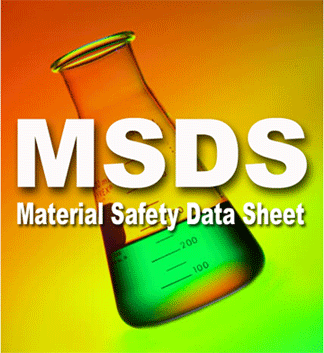
The most commonly used disposable gloves in the medical field and laboratories are nitrile gloves.
While the thin nitrile material provides better resistance to chemicals and acids, it offers only limited protection against chemicals.
In short, they are used as physical barriers against contact with chemicals and must be discarded immediately once contaminated.
When briefly exposed to chemicals, dental nitrile gloves are evaluated on the following basis:
Breakthrough time:
This is the time taken to detect a substance within the glove when the outer surface is exposed to harsh chemicals. Glove materials that can withstand more than eight hours are noted as excellent grade
Degradation time:
The degradation rate indicates the physical changes in the nitrile material when it comes in contact with the chemical substance. Even though the glove material does not exhibit degradation, it will experience a chemical breakdown. Some of the physical changes that take place include:
- Shrinking.
- Cracking.
- Softening.
- Swelling.
Permeation rate:
Once the chemical breakthrough occurs, the permeation rate refers to the penetration of the chemical substance into the glove material. This includes:
- Diffusion of the chemical substance through the gloves.
- Absorption of chemicals on the surface.
- Desorption of chemicals on the inner surface.
Remember, the data obtained through laboratory testing may not be effective when it comes to actual body temperature and hand movements. When nitrile gloves are worn for extended periods and extremely stressed during use, the actual glove protection might be much lesser than the lab facts.
What Are The Uses Of Dental Nitrile Gloves?
Some of the best use of disposable dental nitrile gloves are:
- While performing oral dental care or surgical procedures.
- While coming in contact with dangerous chemicals like formaldehyde or bleach.
- While coming in contact with saliva, mucous membranes, bodily fluids, blood, and other infectious agents.
- While meeting with patients. Remember to use new dentist gloves for each patient. After each consultation, remove them after use and wash your hands thoroughly before wearing a new pair.
By using nitrile gloves, dentists and dental assistants can avoid contamination while handling dental instruments and tools or while touching oral tissues that have come in contact with saliva or blood.
These gloves also prevent the transmission of germs from the dental professional’s hands to the patients while performing dental surgeries or care procedures.
Medical Grade Or Industrial Grade Nitrile Gloves?
In order to select the best nitrile gloves, you need to understand the glove type that suits your needs. Based on application and tasks involved in your job, nitrile gloves come under two grades:
1) Medical Grade
Medical grade examination gloves are best suited for use in the healthcare sectors such as doctor’s offices, hospitals, dental clinics, laboratory settings, and nursing homes.
They are primarily used in areas with a greater chance of coming in contact with environmental contaminants or blood-borne microbes.
Due to the high-risk factor, medical-grade nitrile gloves must undergo rigorous checking and testing and meet the guidelines from FDA. In order to mark medical grade for nitrile gloves in the USA, it must pass the 510k medical device certification set by the FDA.
These gloves must also meet the AQL (acceptable quality limits) laid down by the FDA.
It is a must for all medical or surgical nitrile examination gloves to have an AQL rating of 2.5 or below.
Additionally, these gloves must pass the FDA testing criteria and meet the penetration and permeation levels to be marked as chemotherapy-rated nitrile gloves.
Note that the actual testing takes place by using chemotherapeutic drugs. This makes it safe to use while coming in contact with bodily fluids, blood-borne HIV pathogens, chemotherapy agents, and so on.
The different classes of medical-grade nitrile gloves are:
- Class I Medical-Grade Nitrile Gloves:
The type is best suited for low-risk situations and has the least regulatory measures.
- Class II Medical-Grade Nitrile Gloves:
This class has a higher risk and more regulatory controls than Class I to provide adequate safety to the gloves.
- Class III Medical-Grade Nitrile Gloves:
These gloves are best suited for the highest risk situations and need to meet the highest level of regulatory standards. The Class III options must be tested and approved by the FDA before they can reach the market.
2) Industrial Grade
Industrial grade nitrile gloves are specially designed for heavy-duty applications that involve handling harmful chemicals and harsh solvents.
They are used mainly by factory workers, mechanics, construction workers, cleaners, and so on.
These industrial-grade options deliver different levels of barrier protection, where some happen to be anti-static, making them suitable for those working with electronics or machinery.
These disposable gloves have a thickness of 5+ mil and come with textured patterns in the palms and fingerprints for enhanced grip.
As these gloves are not used in the medical sector, they do not have to meet the 510k medical device certification set by the FDA in the USA.
This grade is primarily used in the food service, janitorial and automotive industries. Though food service industries have specific glove requirements, they’re not as strict as the medical-grade glove specifications.
Though both these gloves are designed to provide excellent tensile strength and durability, each of their specifications is different, making them suitable for these specific tasks.
Things To Consider While Selecting The Best Nitrile Dental Gloves
Planning to purchase and store dental nitrile glove supplies in bulk? Here are some of the aspects you need to keep in mind before making the final decision.
1- Right Thickness:
The majority of the disposable nitrile gloves come in a wide range of gauges or thickness that ranges from 4 to 15 mil.
Most heavy-duty industrial-grade nitrile gloves are available at a thickness of six to eight mils.
The greater the level of thickness, you can enjoy an extra barrier of protection from environmental hazards and harmful chemicals.
The thicker nitrile gloves ensure a longer permeation rate while working with chemicals.
It also guarantees better resistance to punctures and years than the thinner nitrile options. In other words, nitrile gloves with lesser thickness provide better flexibility and dexterity.
When it comes to workers in the food processing industry, opting for thinner gloves is perfect. Having to work for more than eight hours a day, selecting the thinner ones will help reduce tiredness and sweaty hands. However, those in the medical field will have to opt for thicker gloves as they need better barrier protection against potentially hazardous infections.
A double-gloving method is also used to enhance the total breakthrough time of the gloves. However, it can cause overheating and hand fatigue and is best suited for short-duration jobs.
2- Correct Size And Fit:
Nitrile dental gloves are available in different sizes, just like any other disposable gloves.
Gloves that are too small will stress the material and make it overstretched and less protective.
Ones that are too large might easily slip off or get damaged while using, thereby compromising dexterity.
Most nitrile dental gloves are available in various size options that range from XS – 2XL. Getting the right glove fit is crucial, especially for dental practitioners who perform delicate tasks using small tools like dental caps and so on.
So, before you place a bulk order, conduct a sample test first. This will help you select the right nitrile gloves that offer the best fit and feel and match your specific requirements. The general nitrile glove size chart displays:
- Extra-small nitrile gloves – 6 to 7 inches.
- Small nitrile gloves – 7 to 8 inches.
- Medium nitrile gloves – eight to nine inches.
- Large nitrile gloves – 9 to 10 inches.
- Extra-large gloves – 10 to 11 inches.
- 2X large nitrile gloves – 11 to 12 inches.
3- Barrier Protection
The reliability of a glove material keeps varying based on the glove composition.
The barrier protection feature plays a key role in influencing infection control. Depending on the manufacturing process and the material used for making the gloves, the level of protection varies.
Before choosing nitrile gloves, pay careful attention to the barrier integrity that the brand has to offer.
4- Glove Patterns And Textures
Dental practitioners looking for a better feel and enhanced grip while using nitrile gloves must opt for ones with a textured pattern or finish on the gloves’ fingertips and palm.
Diamond textured patterns enhance grip for both wet and dry conditions. Most nitrile gloves come with a chlorinated coat finishing to reduce stickiness.
This makes it easier to don and doff the nitrile gloves without causing any tears.
5- Puncture and Tear Resistance
When the nitrile gloves lack adequate elasticity and flexibility, it becomes more susceptible to tearing while donning or using for extended hours.
Most nitrile gloves are resistant to tears, especially due to the beading around the cuffs.
For those working in an environment where there is a greater risk of stress or puncture, once the nitrile gloves get punctured, they can end up getting split.
Nitrile gloves are coated with stress-resistant material on the inner surface, making donning and doffing easier.
6- Snug Fit
Nitrile gloves that fit perfectly onto your hands without any loose areas and adequate stretchiness ensure great dexterity and comfort.
Thinner nitrile dental gloves provide a snug fit, adequate comfort, and stretchiness.
However, they will not be able to handle wrong sizing and may get punctures or stress.
7- Resistance to Chemicals
While working in the healthcare sector, you may come across hazardous bodily fluids or harmful chemicals in medical laboratories.
Nitrile gloves are uniquely designed to offer a certain amount of resistance against chemicals, acids, solvents, oils, and potentially hazardous infectious agents.
Make sure to go through the certified PPE certifications that guarantee the gloves to be chemical resistant.
Such gloves are specifically designed for chemotherapeutic drug usages.
Powder vs. Powder-Free Nitrile Gloves?
While purchasing nitrile gloves, you will come across two options in the market.
- Powdered nitrile gloves:
The powdered gloves help in absorbing the moisture which makes it easier to don and doff the gloves with ease.
This makes it a popular option for those working in areas where they need to put on and remove the gloves regularly.
However, the powder leaves back a residue That can cause allergic reactions like dermatitis in some individuals.
Additionally, they are not suitable for sterile, surgical environments due to contamination risks from the powder residues.
Hence the FDA has banned the sale and use of powdered medical grade surgical nitrile gloves in the US.
- Powder-free nitrile gloves:
When it comes to the powder-free options, it has a polymer or chlorinated coat finishing in the inner surface of the gloves.
This makes it easy to don and doff the nitrile gloves with creating a mess due to the powder residue.
Benefits Of Nitrile Dental Gloves
By providing a superior touch sensitivity, nitrile gloves enable dental practitioners to perform even the most delicate dental tasks accurately and accurately.
Here are some of the benefits that mark these gloves as the best among the rest:
- Can easily notice any tears, holes, or damages.
- Used as an effective barrier to protect against acids, bases, oils, and hydrocarbons.
- Preferred choice to protect against unexpected splash of chemicals or acids.
- Excellent barrier to chemical solvents.
- Highly resistant to punctures.
- Has a synthetic composition that gives them longer shelf life than the regular rubber latex gloves.
- Available in a broad spectrum of colors, making it easy to match with the dental practice’s clinic décor and color palette.
- Specially used as an alternative in case of latex allergic reactions.
- Molds well to offer a better fit for your hands.
- Provides an incredible level of comfort even after donning it for extended hours.
- Best suited to protect against high-risk infection cases.
- The darker black and blue shades make it easy to identify any holes or tears.
Limitations Of Using Nitrile Gloves
When it comes to the disadvantages, it can be pointed out easily. You will notice nitrile gloves are:
- Non-biodegradable, resulting in a huge amount of waste being emitted into the environment, causing the waste of natural resources and energy.
- Not extremely flexible when compared with the regular latex gloves.
- Due to the ongoing pandemic, the supply is scarce due to high demand.
- Slightly higher priced than the regular rubber gloves, but worth the value.
- May experience a lower tactile sensitivity than the latex gloves.
- Can get damaged when exposed to ultraviolet light, ozone, and oxygen.
Final Thoughts
As dentists come in direct contact with contamination risks that involve bodily fluids, saliva, and blood daily, it is essential to don good quality gloves to prevent the spread of infections and cross-contamination.
It is also the responsibility of dental practitioners and dental hygienists to protect their patients from infectious agents.
This is why it is essential to get your nitrile dental gloves from a certified PPE supplier to guarantee safety and care for yourself, your employees, and your patients.
A slight negligence in procuring the highest grade of quality nitrile gloves can result in dire consequences.
Hence it is advisable to partner with only trusted manufacturers who offer the best quality nitrile dental gloves in the market.

